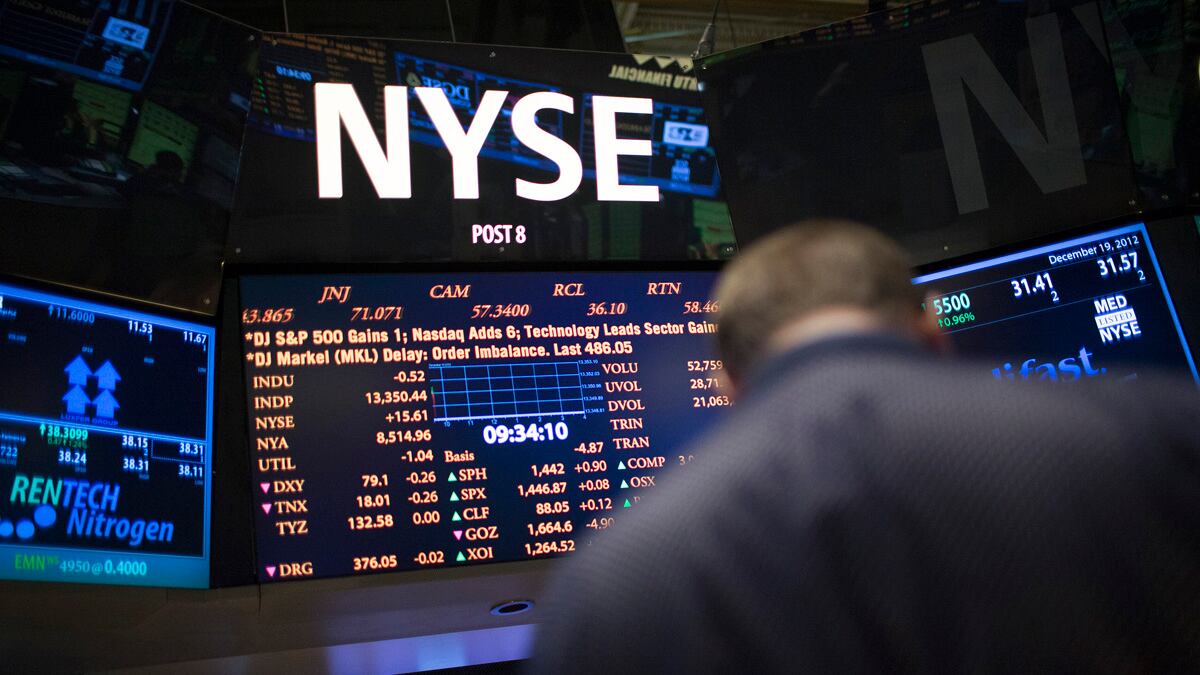And here we thought Big Bird was the New York-based media icon who was endangered in 2012. Turns out it was the Big Board. The New York Stock Exchange, the 220-year-old icon of American capitalism, the fortress-like building that houses the animal spirits of the nations’ investors, the place whose old-school bells signal the opening and closing of the trading day, and whose floors housing anguished faces on days of crashes, and big smiles on up days—it has been sold to ... an upstart derivatives exchange based in Atlanta that is too young for a bar mitzvah.
NYSE agreed Thursday to be purchased by IntercontinentalExchange in a cash-and-stock deal worth $8.2 billion.
The deal was more of a coup de grace than a coup.
The NYSE, like some other prestigious New York-based legacy brands (publishers, retailers, newspapers) is an analog business in an increasingly digital world. Until relatively recently, stock trading in the U.S. worked the way it always had. Buyers and sellers would meet, first under a Buttonwood tree in 1792, and then on the floors, to trade stocks. People would gather around to watch the action. Professional middle-men would pocket a piece of the action. CNBC began to broadcast from the floor, vastly increasing the audience and cementing the centrality of the NYSE In our investing culture.
But massive paradigm shifts have rendered the NYSE a bit player. Over the past 40 years, technology has slowly eroded the business model and primacy of the NYSE. On the NASDAQ, which gained critical mass in the 1970s, buyers and sellers could essentially meet online, without much human intervention. It became the destination of choice for technology companies, many of which have risen from tiny start-ups to the world’s largest: Microsoft, Google, Apple, and Intel. (Today NASDAQ has a tiny physical footprint in Times Square, which is really a television studio and some computers.) Meanwhile, technology enabled the rise of discount brokers, and the trading of stocks in increments of decimal points rather than fractions. That was bad news for the middle-men, the people who owned NYSE seats and the guys in the funny jackets who worked on the floor. As was the case with so many other businesses, it turned out that machines could do the job more quickly and cheaply.
In the past decade, the technological revolution increased in pace. Alternate electronic stock exchanges, like BATS, which started in a strip mall outside Kansas City, allowed traders to conduct deals quickly for even less money. These upstarts appealed to the high-frequency traders who have come to dominate the market. The action in today’s market is no longer about a savvy mutual fund working with a specialist to place orders for a block of shares, and relying on a trusted hand to do so without tipping off the market. Now it’s computers, run by algoirthms, trading hundreds of shares—hundreds of times per minute—on a range of exchanges. That’s where the action is today. As a result, covering the “stock markets” by standing on the floor of the NYSE and looking at the action is a little like covering an election by standing at polling places—when 80 percent of the population votes by mail.

A second trend harmed the NYSE. In the NYSE’s heyday, in the 1950s and 1960s, U.S. stocks were pretty much where the action was. These days, however, sophisticated investors and those with large pools of capital are trading in everything but U.S. equities. The hot action in today’s markets is in foreign stocks, in government and corporate bonds, and especially in derivatives of all sorts—futures, options, structured products. The volatility and spreads in these markets is far greater than it is for stocks, and therefore so is the potential for profits.
That trend has benefitted upstart exchanges like ICE, which stands for IntercontinentalExchange. Founded in 2000 in Atlanta, it has grown rapidly, expanding in Europe and Asia.
NYSE, which remains vital and important, hasn’t been completely aloof from these trends. In 2006, It acquired Archipelago, an electronic exchange. Five years ago, it merged with Euronext, a European electronic exchange. But it is still tethered to its past. And the shifting trends left the company vulnerable. Anybody who works on the floor will tell you that stocks are a futures business, not a past business. A company is valued not so much for what it has done in the last 50 or 200 years, or for what it is doing today, but for what it can do in the future.
In recent years, the stock NYSE hasn’t been doing particularly well—especially compared with the stocks of electronic exchanges with shorter history and smaller footprints. NYSE’s revenues in the most recent quarter were about $900 million, but through the first three quarters of 2012 were off about 20 percent from 2011. When trading closed Wednesday, NYSE had a market capitalization of about $5.8 billion. By contrast, ICE, which had revenues of only $323 million in the most recent quarter, was valued at about $9.3 billion on Wednesday. Why? ICE’s overhead costs are much lower than NYSE’s, and its operating income is rising, not falling.

And so the 12-year-old out-of-towner was in a position to make an aggressive bid for the longtime resident of Broad Street. The dynamic is not dissimilar to the one we say in the 1990s, when dotcom retailers and media companies with short operating histories and small annual sales quickly assumed a greater stock market value than their bricks-and-mortar analogues.
Sure, New York remains the heart of the financial services industry. But the industry’s footprint is simultaneously shrinking in New York and spreading out across the country. Financial power is becoming more diffuse. You don’t need to be in lower Manhattan – or in the tri-state metro areas at all—to run a giant hedge fund, or mutual fund, or a stock exchange.
Now the parent company of the NYSE will be based in a city that didn’t even exist when the traders started meeting under the Buttonwood tree.
Merry Christmas, y’all.






